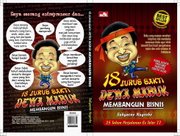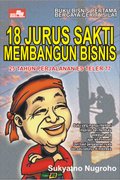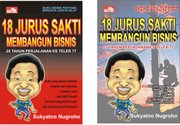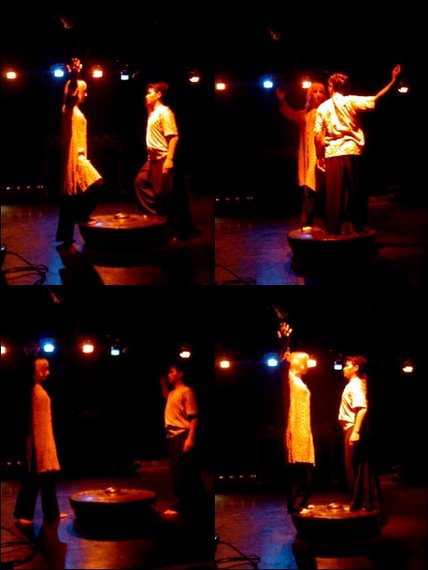Biantoro Wanandi: Choose nanotechnology as company's strategy
Posted by The Jakarta Post daily at Wednesday, September 12, 2007
By Ari Satriyo Wibowo, Contributor, Jakarta
Occupying various positions in the World Health Organization (WHO), Geneva, Switzerland, starting in 1978 as a scientist, then chief of the drug policies and management unit and later program manager of the Drug Action Program, brought little satisfaction to Biantoro Wanandi. The limited operational budget facing WHO at that time and the routine job of his six years at WHO left Biantoro feeling less than challenged, and this built up into a desire and determination to return home in 1983 and become an entrepreneur.
That was the beginning of the Anugerah Corporation, a holding company that now has more than 20 subsidiary companies. Among these companies are three major enterprises, namely PT Combiphar, a manufacturer and marketer of pharmaceuticals, PT Anugerah Pharmindo Lestari (APL), a pharmaceuticals distribution company and PT Tigaka Distrindo Perkasa (TDP), an importer and distributor of active pharmaceutical ingredients (API) and other raw materials.
Biantoro's experience and his Swiss and WHO connections enabled him to build a level of trust with several major players in the international pharmaceutical industry that led to the development of business partnerships with globally renowned companies such as Novartis, Zuellig Pharma, Glaxo Smith Kline and Sanofi-Aventis.
After coming back to Indonesia in 1983, he helped his brothers develop the family business, mainly in the field of automotive, batteries, property, etc. The pharmaceutical industry was, at that time, already saturated and the government had issued a negative investment list that included the pharmaceutical sector. Prior to his time with WHO, Biantoro had developed pharmaceutical business knowledge and skills with Swiss giant Ciba-Geigy and had built a network in the industry spanning 25 years, all of which formed a platform on which he slowly started to develop business opportunities in Indonesia.
He setup PT Anugerah Pharmindo Lestari (APL) in 1985 from scratch and bought PT Combiphar in 1986. He also assisted in the establishment of PT Sandoz Biochemie Farma Indonesia in 1985 and in 1987 he teamed up with Glaxo Ltd to establish PT Glaxo Indonesia.
When asked for his view on the pharmaceutical industry in Indonesia, he commented that the market was very small considering the size of the population and that there were big differences with neighboring countries in income per capita, health care coverage and drug expenditure. The total health expenditure of Indonesia is less than 2 percent of GDP, while in the U.S. it is about 14 percent and in Europe 7 to 11 percent. WHO recommends that it be at least 5 percent of GDP. To cultivate the market, he suggests the government supports the establishment of a suitable health financing system in the country. At present, approximately 85 percent of the population pay their health expenses from their own pockets. The ASKESIN (a type of health insurance for the poor paid by the government) has not developed as anticipated. He suggests that the government encourage more private insurance companies to participate in covering the more affluent segment of the population for financing their health care service requirements. In obtaining affordable premiums from insurance providers, the number of members plays the biggest role. Therefore, a legal framework to oblige all citizens to have health insurance is key. In this way the health care services sector could grow faster and improve in quality, thus improving the health index of the population. Pharmaceutical companies would, of course, also benefit from this development.
The other concern Biantoro shared was the weakness/unreadiness of the Indonesian pharmaceutical industry in meeting quality requirements of their products. A prerequisite to enter/penetrate the ASEAN market and obtain product acceptance by ASEAN's FDA is compliance to Pharmaceutical Inspection Convention (PIC) standards of quality e.g. BA-BE, cGMP, GLP. by 2008. He said that if we were not prepared our products would not be able to enter or be registered in the ASEAN countries.
More than 80 percent of the ASEAN pharmaceutical market, except in Singapore, is made up of generics, therefore our industry could compete with other ASEAN industries. Our main challenge would be to compete with other strong countries like India and China, if they were allowed to enter the ASEAN market. To improve our capabilities, we need a break-through strategy and industries, the government and the academia need to work hand in hand.
As mentioned, products of pharmaceutical producers in Indonesia and other ASEAN countries are mainly generic or relatively uniform. Facing this situation, a management expert from Harvard Business School, Michael E. Porter, suggested three generic strategies, namely overall cost leadership, differentiation and focus to maintain a company's competitive advantage.
Biantoro Wanandi has not selected the product leadership strategy since his company is not a market leader. Also, it is prohibitively expensive to conduct research and development. Instead, Combiphar has introduced a cost leadership strategy. To improve efficiency, Biantoro instructed Combiphar to apply enterprise resources planning (ERP) that integrates various business processes and existing information systems (for example production, logistics, distribution, accounting, finance and human resources).
Combiphar has implemented SAP and was the first pharmaceutical company in Indonesia to do so.
Many efficiencies can be extracted from ERP. In the early stages inventories were reduced from three to two months' stock. Financial statement reports are now finished 10 days earlier than previously and production planning, which was previously conducted once a month, is now done weekly. ERP was an important choice especially as the location of the Combiphar factory is in Padalarang, near Bandung, while its head office is in Jakarta. ERP (together with SAP) has accelerated the company's data collection, and decisions can therefore be made faster.
Combiphar has risen from being the 23th biggest pharmaceutical company in Indonesia to being the 18th. Biantoro aims to make it among the top 10 by 2012.
Following the success with the overall cost leadership strategy, Combiphar is now trying to strengthen its competitive edge by applying a strategy of differentiation. "Our selected differentiation strategy is the application of state-of-the-art nanotechnology in pharmaceutical products -- initially in the OTC area as a new drug delivery system."
Combiphar is conducting technological transfer through a license issued by Advance Pharmaceutical Nanotech in Delaware, the U.S. "Nanotechnology is already being widely applied in various industries such as cosmetics, food and drink, paint, electronics, but only a few pharmaceutical companies have successfully come up with nanotechnology applications in pharmaceuticals or medicines," Biantoro told journalists when hosting a nanotechnology symposium at JW Marriott Hotel Jakarta last month.
Last year, Combiphar launched three new products that are based on nanotechnology: Jointfit, a glucosamine, chondroitin and nano calcium plus nano vitamin D3 (to improve absorption of calcium); Gestabil, containing nano particles of antacid that act faster on stomach acid; Pronemia, a chewable double-layered tablet for patients with anemia and for pregnant women. Anemia is the most common blood disorder in Indonesia, with nearly 60 percent of the population being anemic. Iron is required for the formation of hemoglobin; when there is a shortage of iron in the body it causes iron-deficiency anemia. Pronemia contains nano particles of iron, which helps the formation of red blood cells, and is enriched with vitamin C, vitamin B12 and folic acid. The use of nano iron eliminates the taste of iron, constipation and other stomach problems. "The blueberry taste and the chewable double-layered tablet is well accepted by patients, but the process of disseminating information on it will be time consuming because doctors and consumers must be educated first about the benefits of nanotechnology," said Biantoro.
Prof. Hans P. Merkle, professor of pharmaceutics, head of the Drug Formulation and Delivery Group from the Federal Institute of Technology (ETH), Zurich, Switzerland, who was a classmate of Biantoro's at the institute, was pleased to add his comments, "Well, I've known him for almost 40 years. I do not see him frequently but sometimes I'm amazed with his energy and his enthusiasm and also his capacity to be a successful entrepreneur. I also appreciate his friendship and humor. I like him very much."
Meanwhile, Dr. Chien-Chin Wu, a business partner from Advanced Pharmaceutical Nanotech Inc. (APN), the U.S. said, "I have been working with him for about four years now. I always enjoy talking and working with him because I recognize he has tremendous experience in the industry."
Background:
Name: Dr. Willem Biantoro Wanandi
Place/date of birth: Sawahlunto, West Sumatra, Jan. 30, 1939
Marital status: Married with three children
Education: Doctorate in natural sciences, Swiss Federal Institute of Technology, Zurich, Switzerland (1966-1968)
Work experience:
Currently: Chairman Anugerah Corporation
Currently: President Director PT Combiphar
Currently: Chairman PT Anugerah Pharmindo Lestari (APL)
Currently: Chairman of PT Tigaka Distrindo Perkasa
1983-1987: National project coordinator UNDP/WHO Jakarta
1983-1987: Technical advisor to minister of health for pharmaceutical affairs
1978-1983: Scientist, thereafter head of the drug policies and management unit and later program manager of Drug Action Program for WHO, Geneva, Switzerland
1969-1972: Scientist, Ciba-Geigy Ltd, Basle, Switzerland
(1972-1977): Production manager, member of management committee of PT Ciba Geigy Pharma Indonesia, Jakarta.
By Ari Satriyo Wibowo, Contributor, Jakarta
Occupying various positions in the World Health Organization (WHO), Geneva, Switzerland, starting in 1978 as a scientist, then chief of the drug policies and management unit and later program manager of the Drug Action Program, brought little satisfaction to Biantoro Wanandi. The limited operational budget facing WHO at that time and the routine job of his six years at WHO left Biantoro feeling less than challenged, and this built up into a desire and determination to return home in 1983 and become an entrepreneur.
That was the beginning of the Anugerah Corporation, a holding company that now has more than 20 subsidiary companies. Among these companies are three major enterprises, namely PT Combiphar, a manufacturer and marketer of pharmaceuticals, PT Anugerah Pharmindo Lestari (APL), a pharmaceuticals distribution company and PT Tigaka Distrindo Perkasa (TDP), an importer and distributor of active pharmaceutical ingredients (API) and other raw materials.
Biantoro's experience and his Swiss and WHO connections enabled him to build a level of trust with several major players in the international pharmaceutical industry that led to the development of business partnerships with globally renowned companies such as Novartis, Zuellig Pharma, Glaxo Smith Kline and Sanofi-Aventis.
After coming back to Indonesia in 1983, he helped his brothers develop the family business, mainly in the field of automotive, batteries, property, etc. The pharmaceutical industry was, at that time, already saturated and the government had issued a negative investment list that included the pharmaceutical sector. Prior to his time with WHO, Biantoro had developed pharmaceutical business knowledge and skills with Swiss giant Ciba-Geigy and had built a network in the industry spanning 25 years, all of which formed a platform on which he slowly started to develop business opportunities in Indonesia.
He setup PT Anugerah Pharmindo Lestari (APL) in 1985 from scratch and bought PT Combiphar in 1986. He also assisted in the establishment of PT Sandoz Biochemie Farma Indonesia in 1985 and in 1987 he teamed up with Glaxo Ltd to establish PT Glaxo Indonesia.
When asked for his view on the pharmaceutical industry in Indonesia, he commented that the market was very small considering the size of the population and that there were big differences with neighboring countries in income per capita, health care coverage and drug expenditure. The total health expenditure of Indonesia is less than 2 percent of GDP, while in the U.S. it is about 14 percent and in Europe 7 to 11 percent. WHO recommends that it be at least 5 percent of GDP. To cultivate the market, he suggests the government supports the establishment of a suitable health financing system in the country. At present, approximately 85 percent of the population pay their health expenses from their own pockets. The ASKESIN (a type of health insurance for the poor paid by the government) has not developed as anticipated. He suggests that the government encourage more private insurance companies to participate in covering the more affluent segment of the population for financing their health care service requirements. In obtaining affordable premiums from insurance providers, the number of members plays the biggest role. Therefore, a legal framework to oblige all citizens to have health insurance is key. In this way the health care services sector could grow faster and improve in quality, thus improving the health index of the population. Pharmaceutical companies would, of course, also benefit from this development.
The other concern Biantoro shared was the weakness/unreadiness of the Indonesian pharmaceutical industry in meeting quality requirements of their products. A prerequisite to enter/penetrate the ASEAN market and obtain product acceptance by ASEAN's FDA is compliance to Pharmaceutical Inspection Convention (PIC) standards of quality e.g. BA-BE, cGMP, GLP. by 2008. He said that if we were not prepared our products would not be able to enter or be registered in the ASEAN countries.
More than 80 percent of the ASEAN pharmaceutical market, except in Singapore, is made up of generics, therefore our industry could compete with other ASEAN industries. Our main challenge would be to compete with other strong countries like India and China, if they were allowed to enter the ASEAN market. To improve our capabilities, we need a break-through strategy and industries, the government and the academia need to work hand in hand.
As mentioned, products of pharmaceutical producers in Indonesia and other ASEAN countries are mainly generic or relatively uniform. Facing this situation, a management expert from Harvard Business School, Michael E. Porter, suggested three generic strategies, namely overall cost leadership, differentiation and focus to maintain a company's competitive advantage.
Biantoro Wanandi has not selected the product leadership strategy since his company is not a market leader. Also, it is prohibitively expensive to conduct research and development. Instead, Combiphar has introduced a cost leadership strategy. To improve efficiency, Biantoro instructed Combiphar to apply enterprise resources planning (ERP) that integrates various business processes and existing information systems (for example production, logistics, distribution, accounting, finance and human resources).
Combiphar has implemented SAP and was the first pharmaceutical company in Indonesia to do so.
Many efficiencies can be extracted from ERP. In the early stages inventories were reduced from three to two months' stock. Financial statement reports are now finished 10 days earlier than previously and production planning, which was previously conducted once a month, is now done weekly. ERP was an important choice especially as the location of the Combiphar factory is in Padalarang, near Bandung, while its head office is in Jakarta. ERP (together with SAP) has accelerated the company's data collection, and decisions can therefore be made faster.
Combiphar has risen from being the 23th biggest pharmaceutical company in Indonesia to being the 18th. Biantoro aims to make it among the top 10 by 2012.
Following the success with the overall cost leadership strategy, Combiphar is now trying to strengthen its competitive edge by applying a strategy of differentiation. "Our selected differentiation strategy is the application of state-of-the-art nanotechnology in pharmaceutical products -- initially in the OTC area as a new drug delivery system."
Combiphar is conducting technological transfer through a license issued by Advance Pharmaceutical Nanotech in Delaware, the U.S. "Nanotechnology is already being widely applied in various industries such as cosmetics, food and drink, paint, electronics, but only a few pharmaceutical companies have successfully come up with nanotechnology applications in pharmaceuticals or medicines," Biantoro told journalists when hosting a nanotechnology symposium at JW Marriott Hotel Jakarta last month.
Last year, Combiphar launched three new products that are based on nanotechnology: Jointfit, a glucosamine, chondroitin and nano calcium plus nano vitamin D3 (to improve absorption of calcium); Gestabil, containing nano particles of antacid that act faster on stomach acid; Pronemia, a chewable double-layered tablet for patients with anemia and for pregnant women. Anemia is the most common blood disorder in Indonesia, with nearly 60 percent of the population being anemic. Iron is required for the formation of hemoglobin; when there is a shortage of iron in the body it causes iron-deficiency anemia. Pronemia contains nano particles of iron, which helps the formation of red blood cells, and is enriched with vitamin C, vitamin B12 and folic acid. The use of nano iron eliminates the taste of iron, constipation and other stomach problems. "The blueberry taste and the chewable double-layered tablet is well accepted by patients, but the process of disseminating information on it will be time consuming because doctors and consumers must be educated first about the benefits of nanotechnology," said Biantoro.
Prof. Hans P. Merkle, professor of pharmaceutics, head of the Drug Formulation and Delivery Group from the Federal Institute of Technology (ETH), Zurich, Switzerland, who was a classmate of Biantoro's at the institute, was pleased to add his comments, "Well, I've known him for almost 40 years. I do not see him frequently but sometimes I'm amazed with his energy and his enthusiasm and also his capacity to be a successful entrepreneur. I also appreciate his friendship and humor. I like him very much."
Meanwhile, Dr. Chien-Chin Wu, a business partner from Advanced Pharmaceutical Nanotech Inc. (APN), the U.S. said, "I have been working with him for about four years now. I always enjoy talking and working with him because I recognize he has tremendous experience in the industry."
Background:
Name: Dr. Willem Biantoro Wanandi
Place/date of birth: Sawahlunto, West Sumatra, Jan. 30, 1939
Marital status: Married with three children
Education: Doctorate in natural sciences, Swiss Federal Institute of Technology, Zurich, Switzerland (1966-1968)
Work experience:
Currently: Chairman Anugerah Corporation
Currently: President Director PT Combiphar
Currently: Chairman PT Anugerah Pharmindo Lestari (APL)
Currently: Chairman of PT Tigaka Distrindo Perkasa
1983-1987: National project coordinator UNDP/WHO Jakarta
1983-1987: Technical advisor to minister of health for pharmaceutical affairs
1978-1983: Scientist, thereafter head of the drug policies and management unit and later program manager of Drug Action Program for WHO, Geneva, Switzerland
1969-1972: Scientist, Ciba-Geigy Ltd, Basle, Switzerland
(1972-1977): Production manager, member of management committee of PT Ciba Geigy Pharma Indonesia, Jakarta.











